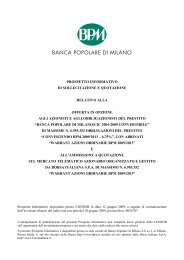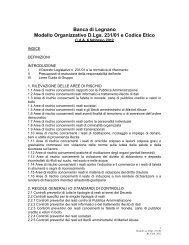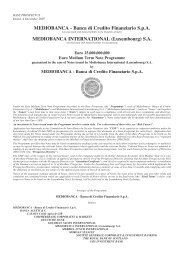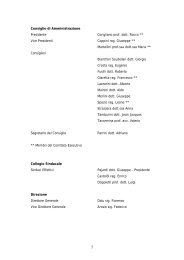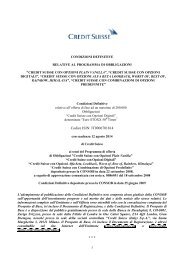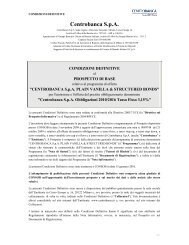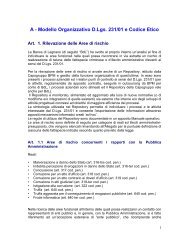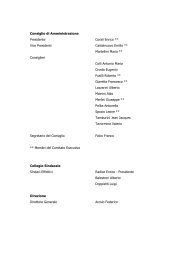INDEX OF DEFINED TERMS - Banca di Legnano
INDEX OF DEFINED TERMS - Banca di Legnano
INDEX OF DEFINED TERMS - Banca di Legnano
You also want an ePaper? Increase the reach of your titles
YUMPU automatically turns print PDFs into web optimized ePapers that Google loves.
Level: 2 – From: 2 – Wednesday, July 21, 2010 – 14:35 – eprint6 – 4247 Section 03<br />
regard to the permissibility of such acquisitions under state law, but subject to any state requirement that<br />
the bank has been organized and operating for a minimum period of time, not to exceed five years, and the<br />
requirements that the bank hol<strong>di</strong>ng company, after the proposed acquisition, controls no more than 10 per<br />
cent. of the total amount of deposits of insured depository institutions in the United States and no more<br />
than 30 per cent. or such lesser or greater amount set by state laws of such deposits in that state. At<br />
December 31, 2009, the Issuer controlled approximately 12 per cent. of total deposits of insured<br />
institutions in the United States. Subject to certain restrictions, the Interstate Banking and Branching Act<br />
also permits a bank to open new branches in a state in which it does not already have banking operations if<br />
such state enacts a law permitting de novo branching.<br />
2. Changes in Regulations<br />
Proposals to change the laws and regulations governing the banking and financial services industry<br />
are frequently introduced in the U.S. Congress, in the state legislatures and before the various bank<br />
regulatory agencies as well as by lawmakers and regulators in juris<strong>di</strong>ctions outside the United States where<br />
the Issuer operates. For example, in 2009, the U.S. Department of the Treasury (the “U.S. Treasury”), the<br />
FDIC, and the Federal Reserve Board developed programs and facilities designed to support the banking<br />
and financial services industries during the financial crisis. The U.S. Congress and the U.S. government<br />
have continued to evaluate and develop legislation, programs and initiatives designed to, among other<br />
things, stabilize the U.S. financial and housing markets, stimulate the U.S. economy, inclu<strong>di</strong>ng the U.S.<br />
government’s foreclosure prevention program, and prevent future financial crises by further regulating the<br />
financial services industry. As a result of the financial crisis and challenging economic environment, the<br />
Issuer expects ad<strong>di</strong>tional changes to be proposed and continued legislative and regulatory scrutiny of the<br />
financial services industry. The final form of any proposed programs or initiatives or related legislation, the<br />
likelihood and timing of any other future proposals or legislation, and the impact they might have on the<br />
Issuer cannot be determined at this time.<br />
3. Capital and Operational Requirements<br />
Regulatory Matters<br />
The Federal Reserve Board, the Comptroller and the FDIC have issued substantially similar riskbased<br />
and leverage capital guidelines applicable to U.S. banking organizations. In ad<strong>di</strong>tion, these<br />
regulatory agencies may from time to time require that a banking organization maintain capital above the<br />
minimum levels, whether because of its financial con<strong>di</strong>tion or actual or anticipated growth. The Federal<br />
Reserve Board risk-based guidelines define a three-tier capital framework. Tier 1 capital includes common<br />
shareholders’ equity, trust preferred securities noncontrolling interests, qualifying preferred stock and any<br />
Common Equivalent Securities (“CES”), less goodwill and other adjustments. Tier 2 capital consists of<br />
preferred stock not qualifying as Tier 1 capital, mandatorily convertible debt, limited amounts of<br />
subor<strong>di</strong>nated debt, other qualifying term debt, the allowance for cre<strong>di</strong>t losses up to 1.25 per cent. of riskweighted<br />
assets and other adjustments. Tier 3 capital includes subor<strong>di</strong>nated debt that is unsecured, fully<br />
paid, has an original maturity of at least two years, is not redeemable before maturity without prior<br />
approval by the Federal Reserve Board and includes a lock-in clause preclu<strong>di</strong>ng payment of either interest<br />
or principal if the payment would cause the issuing bank’s risk-based capital ratio to fall or remain below<br />
the required minimum. The sum of Tier 1 and Tier 2 capital less investments in unconsolidated<br />
subsi<strong>di</strong>aries represents the Issuer’s qualifying total capital. Risk-based capital ratios are calculated by<br />
<strong>di</strong>vi<strong>di</strong>ng Tier 1 and total capital by risk-weighted assets. Assets and off-balance sheet exposures are<br />
assigned to one of four categories of risk-weights, based primarily on relative cre<strong>di</strong>t risk. The minimum<br />
Tier 1 capital ratio is four per cent. and the minimum total capital ratio is eight per cent. The Issuer’s Tier<br />
1 and total risk-based capital ratios under these guidelines at December 31, 2009 were 10.40 per cent. and<br />
14.66 per cent. At December 31, 2009, the Issuer had no subor<strong>di</strong>nated debt that qualified as Tier 3 capital.<br />
While not an explicit requirement of law or regulation, bank regulatory agencies have stated that they<br />
expect common capital to be the primary component of a financial hol<strong>di</strong>ng company’s Tier 1 capital and<br />
44



